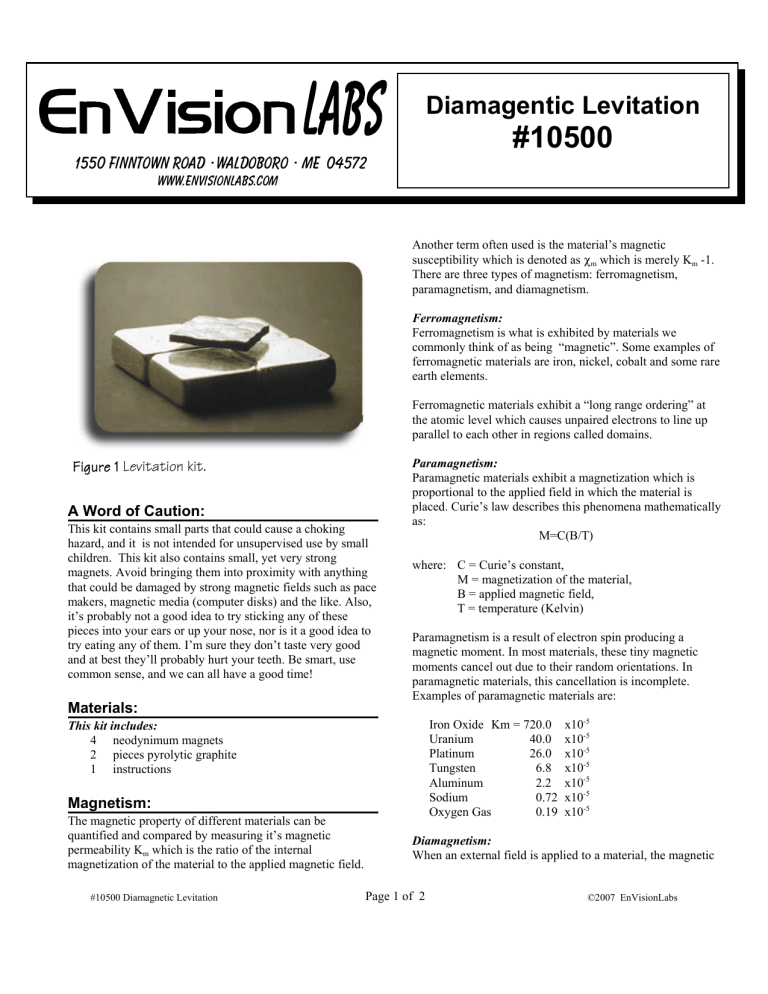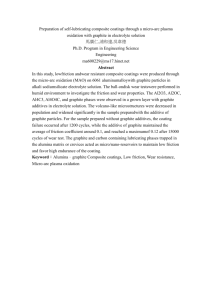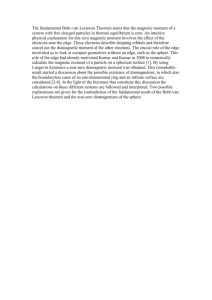#10500 Diamagentic Levitation @ 1550 Finntown Road

Diamagentic Levitation
#10500
1550 Finntown Road
@
Waldoboro
@
ME 04572
www.envisionlabs.com
Figure 1 Levitation kit.
A Word of Caution:
This kit contains small parts that could cause a choking hazard, and it is not intended for unsupervised use by small children. This kit also contains small, yet very strong magnets. Avoid bringing them into proximity with anything that could be damaged by strong magnetic fields such as pace makers, magnetic media (computer disks) and the like. Also, it’s probably not a good idea to try sticking any of these pieces into your ears or up your nose, nor is it a good idea to try eating any of them. I’m sure they don’t taste very good and at best they’ll probably hurt your teeth. Be smart, use common sense, and we can all have a good time!
Materials:
This kit includes:
2 pieces pyrolytic graphite
1 instructions
Magnetism:
The magnetic property of different materials can be quantified and compared by measuring it’s magnetic permeability K m
which is the ratio of the internal magnetization of the material to the applied magnetic field.
#10500 Diamagnetic Levitation
Page 1 of 2
Another term often used is the material’s magnetic susceptibility which is denoted as
P m
which is merely K m
-1.
There are three types of magnetism: ferromagnetism, paramagnetism, and diamagnetism.
Ferromagnetism:
Ferromagnetism is what is exhibited by materials we commonly think of as being “magnetic”. Some examples of ferromagnetic materials are iron, nickel, cobalt and some rare earth elements.
Ferromagnetic materials exhibit a “long range ordering” at the atomic level which causes unpaired electrons to line up parallel to each other in regions called domains.
Paramagnetism:
Paramagnetic materials exhibit a magnetization which is proportional to the applied field in which the material is placed. Curie’s law describes this phenomena mathematically as:
M=C(B/T) where: C = Curie’s constant,
M = magnetization of the material,
B = applied magnetic field,
T = temperature (Kelvin)
Paramagnetism is a result of electron spin producing a magnetic moment. In most materials, these tiny magnetic moments cancel out due to their random orientations. In paramagnetic materials, this cancellation is incomplete.
Examples of paramagnetic materials are:
Iron Oxide Km = 720.0
x10 -5
Uranium
Platinum
Tungsten
40.0
x10 -5
26.0
x10 -5
6.8
x10 -5
Aluminum
Sodium
Oxygen Gas
2.2
x10 -5
0.72 x10 -5
0.19 x10 -5
Diamagnetism:
When an external field is applied to a material, the magnetic
©2007 EnVisionLabs
moments produced by the tiny current loops caused by the orbital motion of electrons, tend to align themselves in such a way as to oppose the applied magnetic field (Lenz’s Law).
Materials in which this is the only response are called diamagnetic.
All materials are inherently diamagnetic. However, if the atoms have some net magnetic moment, as in paramagnetic materials, or if there is long range ordering of atomic magnetic moments; these effects are dominant.
Any electrical conductor will show a strong diamagnetic effect in the presence of a changing magnetic field because circulating currents will be generated in the conductor to oppose the magnetic field changes. A super conductor makes a perfect diamagnet because there is no resistance to the formation of current loops.
Examples of diamagnetic materials are:
Water -0.91 x10 -5
Sodium Chloride -1.4
x10
Carbon (graphite) -1.6
x10
-5
-5
Carbon (diamond) -2.1
x10 -5
Pyrolytic Graphite -8.5
x10 -5 (parallel to face)
Bismuth -16.6
x10 -5
Pyrolytic Graphite -45.0
x10 -5 (perpendicular to face)
Pyrolytic Graphite:
Pyrolytic graphite is a synthetic material, made by a process called chemical vapor deposition. To make pyrolytic graphite, methane gas at low pressure (about 1 Torr) is heated to approximately 2000 degrees Celsius. Very slowly, (one thousandth of an inch per hour) a layer of graphite grows.
The graphite made this way is very highly ordered, and the layers of carbon atoms form hexagonal crystals in plate-like sheets which build up like sheets of mica.
Using the Materials:
Arrange the magnets in a square as shown in the illustration.
They should click into place, if not, try flipping the offending magnet upside down and try it again. Also, if you happen to have a small piece of metal, such as a “tin” box that would normally contain breath mints, sticking the magnets on this material will keep them together make them easier to handle and move around if you’re doing the “show and tell” thing.
Once the magnets are in place, gently position the square of graphite over the center of the magnets and let it go! The graphite should instantly settle into place and gently sway back and forth in the magnetic “well” you’ve created. The distance the graphite floats above the magnet’s surface depends upon the strength of the magnets and the weight of the graphite. You can take a hobby knife and split the graphite into thinner layers to make lighter pieces that will float a little higher above the magnets. Another fun thing that can be done to demonstrate that the graphite is really floating freely above the magnets is to tear off a small strip of paper and then slide it underneath the levitating graphite. You should be able to pass the strip of paper under the graphite without disturbing it. This is very cool!
#10500 Diamagnetic Levitation Page 2 of 2 ©2007 EnVisionLabs



